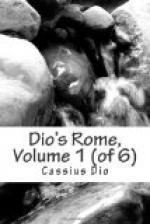[Footnote 1: Iahni Annales, vol. 141, p. 290 sqq.]
The world has, then, in this twentieth century, those entire books of Dio which have already been mentioned,—Thirty-six to Sixty,—and something more. Let us first consider, accordingly, the condition in which this intact remnant has come down to the immediate present, and afterward the sources on which we have to depend for a knowledge of the lost portion.
There are eleven manuscripts for this torso of Roman History, taking their names from the library of final deposit, but they are not all, by any means, of equal value. First come Mediceus A (referred to in this book as Ma), Vaticanus A, Parisinus A, and Venetus A (Va) of the first class; then Mediceus B of the second class; finally, Parisinus B, Escorialensis, Turinensis, Vaticanus B, and Venetus B, with the mongrel Vesontinus, which occupies a position in this group best designated, perhaps, as 2-1/2.
Vaticanus A has been copied from Mediceus A, and Parisinus A from Vaticanus A, so that they are practically one with their archetype. Venetus A is of equal age and authority with Mediceus A. One can not now get back of these two codices. There is none of remoter date for Dio save the parchment Cod. Vat. 1288, containing most of Books Seventy-eight and Seventy-nine,—a portion of the work for the moment not under discussion. Coming to the second class, Mediceus B is a joint product of copying from the two principal MSS. just mentioned. In the third class, Parisinus B is a copy of Mediceus B with a little at the opening taken from Mediceus A. This was the version selected as a guide by Robert Estienne in the first important edition of Dio ever published (A.D. 1548). All the rest, Escorialensis, Turinensis, Vaticanus B, and Venetus B are mere offshoots of Parisinus B. The Vesontinus codex is derived partly from Venetus A and partly from some manuscript of the third class.




